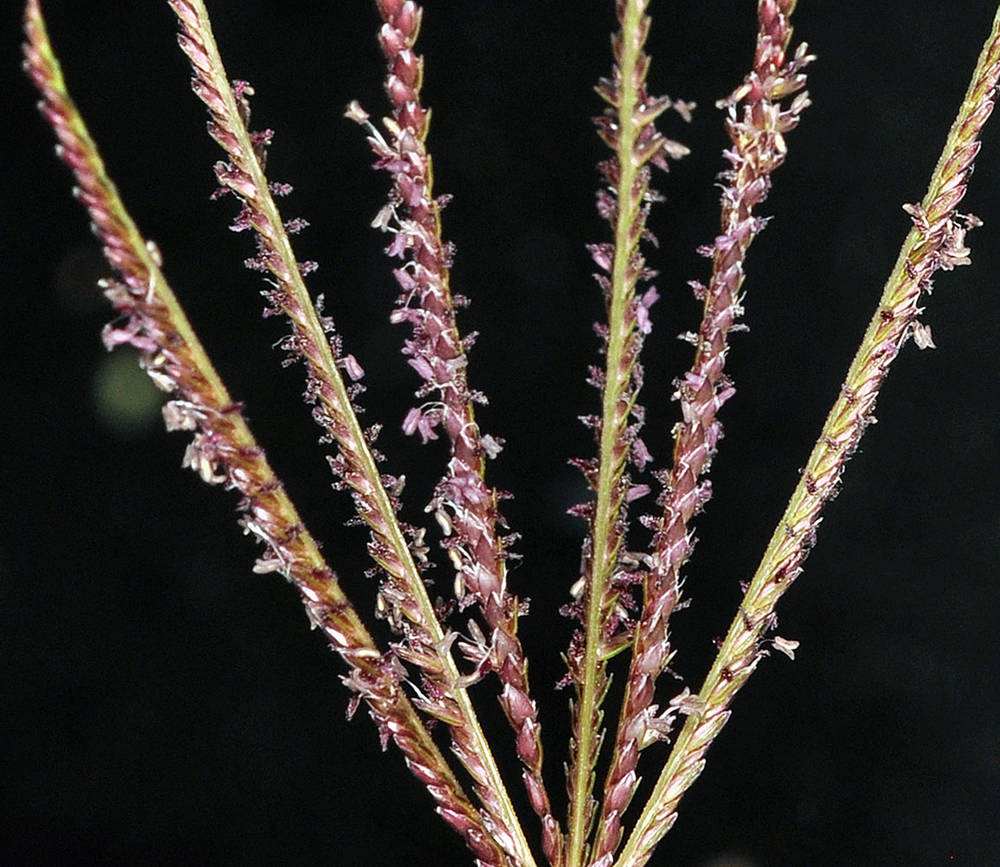Cynodon dactylon
Cynodon
bermudagrass
bermudagrass
sheaths glabrous or with scattered hairs;
blades 1–6(16)cm × (1)2–4(5)mm; flat or folded, glabrous or upper adaxial surface with spreading hairs.
sheaths open, ligules of hairs or membranous;
blades flat, folded, or involute.
with 1 whorl of (3)4–7(9) spike-like branches 1.4–6 cm × 1–2 mm;
spikelets in 2 rows on one side of each branch.
panicles with spike-like branches attached at approximately the same point like spokes of an umbrella;
branches 1-sided, with 2 rows of solitary, appressed, overlapping spikelets.
2–3.2 mm.
laterally compressed, with 1(3) florets (if more than one, only the lowest fertile);
disarticulation above the glumes.
1-veined;
lower glumes 1.2–2 mm;
upper glumes 1.4–2.3 mm.
shorter than the lemmas, keeled, 1-veined or the upper sometimes 3-veined, sometimes short-awned.
1.9–3.1 mm, 3-veined, usually densely pubescent on the keel, sometimes pubescent on the margins; awnless.
keeled, sometimes winged;
tip pointed.
about 1 mm, dehiscent.
3.
=36.
Cynodon dactylon
Cynodon
Lawns, waste areas in urban areas and sandbars on rivers. 0–1200 m. Col, Est, Lava, Sisk, WV. CA, ID, NV, WA; throughout most of North America; worldwide. Exotic.
This grass is commonly planted for forage, lawns, and erosion control in warm climates. It readily escapes, usually in disturbed urban settings and along transportation corridors but sometimes into more natural habitats. Cynodon dactylon is highly diverse in inflorescence branch length, branch number, and lemma hairiness.
Warmer regions worldwide. 9 species; 1 species treated in Flora.
Cynodon species are widely planted as lawn and pasture grasses. Some of the cultivated forms are derived from hybrids between C. dactylon and C. transvaalensis. These hybrids are smaller plants than C. dactylon with narrower leaf blades, fewer panicle branches, and anthers that are indehiscent at maturity.
Barbara Wilson, Richard Brainerd, Nick Otting
Barbara Wilson, Richard Brainerd, Nick Otting
- Local floras:
BC,
CA,
OR,
WA
- Local Web sites:
CalFlora,
CalPhotos,
Flora NW,
PNW Herbaria
WildflowerSearch
iNaturalist (observations)
USDA Plants Database
- LBJ Wildflower Center
- SEINet
- Plants of the World Online
- Encyclopedia of Life
- Wikipedia
- Google Image Search
- Local floras:
CA,
OR,
WA
- Local Web sites:
CalFlora,
CalPhotos,
Flora NW,
PNW Herbaria
WildflowerSearch
iNaturalist (observations)
USDA Plants Database
- LBJ Wildflower Center
- SEINet
- Plants of the World Online
- Encyclopedia of Life
- Wikipedia
- Google Image Search



